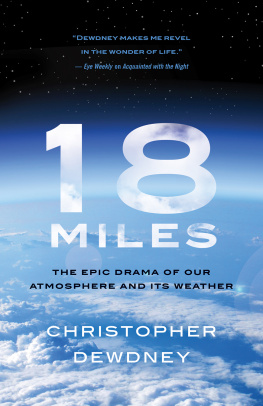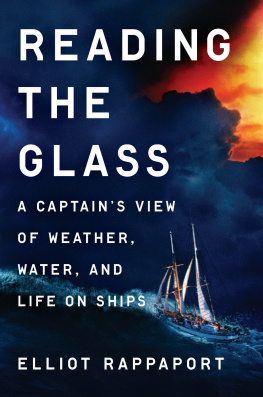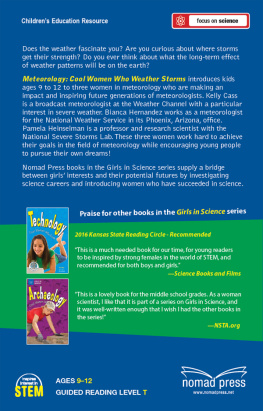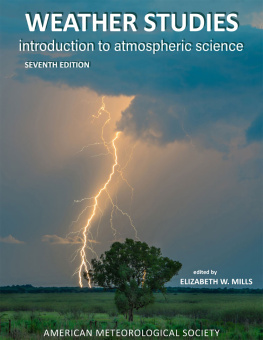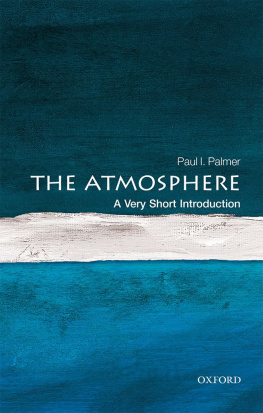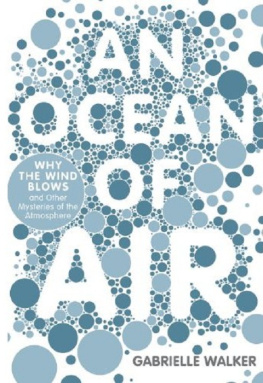Sunshine is delicious, rain is refreshing, wind braces us up, snow is exhilarating; there really is no such thing as bad weather, only different kinds of good weather.
John Ruskin
Youd never guess it but we live in a world flatter than a sheet of paper. Shrink the Earth to the size of a basketball and our atmosphere would be as thick as a layer of food wrap. The oceans likewise. Two of the most critical elements for our survival, water and air, are relatively scarce commodities. We are like microorganisms living in an evanescent fluid film, a dampness that would burn off like morning dew if the sun increased its solar output by just 15 percent.
Astronauts know all of this. From the space station, they see the tops of clouds spread out at the surface of the atmosphere like smoke beneath glass. And slipping back under that thin blanket of air is a real challenge. Their reentry angle can be no shallower than 5.3 and no steeper than 7.7 too shallow and they will ricochet into deep space, too steep and they will burn to a crisp.
Yet its also a question of scale. The vantage from here, from Earths surface, is of another order entirely. The sky seems to go on forever. When a waning moon shines by day, it looks to me as if its suspended in the same blue atmosphere I breathe. No wonder Icarus dreamed of flying to the sun. And the immeasurable vastness of clouds, taller than mountains, what could contain that immensity?
For us, the atmosphere is a theater beyond reckoning, a massive, transparent stage for the drama of the skies. Every sunset is a light show; every storm a nail-biting, colossal thriller. Weather inspires our emotions and sometimes seems to reflect them. There is nothing more romantic than a rainy evening for newlyweds on their honeymoon, and how many philosophers have paced through windy streets deep in thought?
When I was a boy, the wind was a mood, a way of being, a kind of delirium that called me out of my house. I raced the leaves blowing along the street or stood at the edge of the ravine to hear the winds soft thunder in my ears. Clouds were another mood. At sunset, they transformed into dreamlike landscapes inviting the secret empire of night. I was fascinated by weather. Every season was a new universe, the next chapter in an epic story I made up as I went along.
January found me at a research station in Antarctica in the ravine behind my parents house. There I braved subzero blizzards to map glaciers with my special team of explorers, handpicked from neighborhood friends. Once, with amazing luck, we unearthed the frozen carcass of a mammoth, and on another expedition there was a time warp in the middle of a particularly dense snowfall, and we came face-to-face with a snarling saber-toothed tiger that charged out of the blizzard. Fortunately, we survived.
One hot July, there was a softball game followed by an expedition to explore the upper reaches of the Amazon in the same ravine the raucous calls of howler monkeys echoed through the rainforest while treacherous Komodo dragons rustled in the undergrowth. We came upon the forest trails of lost tribes, sometimes catching glimpses of their ocher-painted skin as they disappeared around the bend of a trail. Of course, since then Ive discovered that mammoths didnt visit Antarctica, nor do Komodo dragons inhabit Brazil, but Ive never lost my deep connection with climate and weather.
When I was a little older, in my early teens, I was fascinated by weather forecasts. Forecasters were scientific magicians who could conjure storms out of a sunny afternoon. From Weather: A Golden Nature Guide, a book my parents bought me, I began to learn the weather signs: a ring around the sun meant rain within one to two days; earth glow on the moon (when the dark side of a half-moon is faintly visible) was the reflection of masses of white clouds to the west, an almost sure sign of rain to come. There were illustrations of hurricanes and tornadoes and sun dogs. Now I was really hooked.
Then one afternoon, while leafing through my new copy of the Edmund Scientific mail-order catalog, among the usual assortment of tempting items ant farms, glow-in-the-dark stick-on stars, aquariums, test tubes I noticed a new item, a complete home weather station that included an outdoor anemometer (those whirling wind cups that measure wind speed). I had to have it. I saved my allowance and made extra money doing yard work.
When the package arrived, it was a little smaller than I expected, but everything was in there, including the glorious anemometer with its three wind cups. I blew on them and they twirled obediently, orbiting the little mast. There was also a separate spar for the wind vane, and both had connections for wires that led to my indoor instrument panel. All I had to do was install the wind vane and anemometer high enough to give accurate readings, which wouldnt be easy. It meant I had to make a trek to the top of my parents house.
The afternoon of the installation was cool and windy. I climbed out of an attic window that was barely big enough to squeeze through and then screwed the base for both masts into the wooden gable above the dormer at the peak of the house. I imagined being captured by a National Geographic photographer as I braved the harsh mountain gales to install my weather station. After setting up the anemometer and wind vane, I connected the wires and threw the loose coils over the eaves in the general direction of my bedroom window below. Then I clambered back inside.
In my bedroom, I snared the dangling wires with a rake and pulled them through the window. Id already installed the two wall-mounted, battery-powered weather gauges that the wires would connect to, one for wind velocity and the other for wind direction. Then came the moment of truth if nothing happened, if the instrument panel was dead, Id have to trek back to the roof to check the connections. I hooked up the wires, and the gauges danced to life.
The directional gauge was a circular compass with a little arrow that pointed out the wind direction in tandem with the vane on the roof mast. The velocity gauge was horizontal with a needle indicator like an old-fashioned speedometer in an automobile dashboard that showed a wavering wind speed of about 20 miles per hour. I was euphoric. Along with the barometer and window thermometer that Id previously mounted, I now had a professional indoor weather station. I could take instrument readings from the comfort of my own bedroom no matter what the weather outside, and, more importantly, I could make my own weather forecasts, going mano a mano against the evening news weatherman.
By combining weather signs with instrument readings, I became a pretty good forecaster. I learned that a halo around the moon at night along with falling barometric pressure meant that it would probably rain within 18 to 48 hours. When an east wind shifted to the west and the cloud bases got higher and the barometer was rising, fair weather usually followed. In the winter, a north wind that shifted counterclockwise to become a west wind and then a southerly wind meant that snow was likely within a day.
Later I discovered that I could make pretty good predictions especially of stormy weather using only wind direction and my barometer. If the wind was blowing out of the south and then shifted to the east and my barometer was 29.8 inches or below and falling rapidly, a severe storm was imminent. The same was true if the wind shifted from east to north, especially in the winter and my barometer again was showing 29.8 inches or below and falling rapidly. I usually compared my results to the evening news weather report. I wasnt always right there were some things I just couldnt see coming without a satellite view and upper-atmosphere readings but I did pretty well considering.

